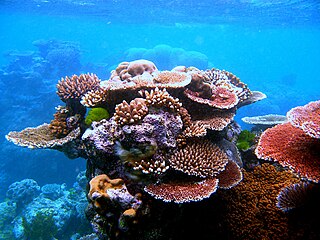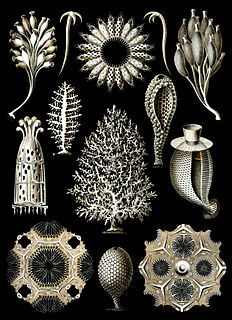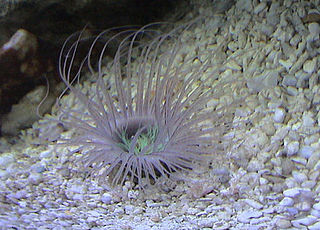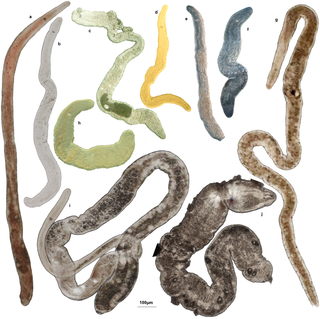 W
WAnthozoa is a class of marine invertebrates which includes the sea anemones, stony corals and soft corals. Adult anthozoans are almost all attached to the seabed, while their larvae can disperse as part of the plankton. The basic unit of the adult is the polyp; this consists of a cylindrical column topped by a disc with a central mouth surrounded by tentacles. Sea anemones are mostly solitary, but the majority of corals are colonial, being formed by the budding of new polyps from an original, founding individual. Colonies are strengthened by calcium carbonate and other materials and take various massive, plate-like, bushy or leafy forms.
 W
WBeroidae is a family of ctenophores or comb jellies more commonly referred to as the beroids. It is the only family within the monotypic order Beroida and the class Nuda. They are distinguished from other comb jellies by the complete absence of tentacles, in both juvenile and adult stages. Species of the family Beroidae are found in all the world's oceans and seas and are free-swimmers that form part of the plankton.
 W
WThe calcareous sponges of class Calcarea are members of the animal phylum Porifera, the cellular sponges. They are characterized by spicules made out of calcium carbonate in the form of calcite or aragonite. While the spicules in most species have three points, in some species they have either two or four points.
 W
WTube-dwelling anemones or ceriantharians look very similar to sea anemones but belong to an entirely different subclass of anthozoans. They are solitary, living buried in soft sediments. Tube anemones live inside and can withdraw into tubes, which are composed of a fibrous material made from secreted mucus and threads of nematocyst-like organelles known as ptychocysts. Within the tubes of these ceriantharians, more than one polyp is present, which is an exceptional trait because species that create tube systems usually contain only one polyp per tube. Ceriantharians were formerly classified in the taxon Ceriantipatharia along with the black corals but have since been moved to their own subclass, Ceriantharia.
 W
WBox jellyfish are cnidarian invertebrates distinguished by their cube-shaped medusae. Some species of box jellyfish produce extremely potent venom: Chironex fleckeri, Carukia barnesi and Malo kingi. Stings from these and a few other species in the class are extremely painful and can be fatal to humans.
 W
WHexacorallia is a class of Anthozoa comprising approximately 4,300 species of aquatic organisms formed of polyps, generally with 6-fold symmetry. It includes all of the stony corals, most of which are colonial and reef-forming, as well as all sea anemones, and zoanthids, arranged within five extant orders. The hexacorallia are distinguished from another class of Anthozoa, Octocorallia, in having six or fewer axes of symmetry in their body structure; the tentacles are simple and unbranched and normally number more than eight. These organisms are formed of individual soft polyps which in some species live in colonies and can secrete a calcite skeleton. As with all Cnidarians, these organisms have a complex life cycle including a motile planktonic phase and a later characteristic sessile phase. Hexacorallia also include the significant extinct order of rugose corals.
 W
WMyxozoa is an unranked subphylum of aquatic, obligately parasitic cnidarian animals and contains the smallest animals ever known to have lived. Over 2180 species have been described and some estimates have suggested at least 30,000 undiscovered species. Many have a two-host lifecycle, involving a fish and an annelid worm or a bryozoan. The average size of a myxosporean spore usually ranges from 10 μm to 20 μm, whereas that of a malacosporean spore can be up to 2 mm. Myxozoans can live in both freshwater and marine habitats.
 W
WNemertodermatida is a class of Acoelomorpha, comprising 18 species of millimetre-sized turbellariform, mostly interstitial worms.
 W
WPolypodium is a genus of parasite attacking the eggs of sturgeon and similar fishes. It is one of the few metazoans (animals) that live inside the cells of other animals.
 W
WTentaculata is a class of comb jellies. The common feature of this class is a pair of long, feathery, contractile tentacles, which can be retracted into specialised ciliated sheaths. In some species, the primary tentacles are reduced and they have smaller, secondary tentacles. The tentacles have colloblasts, which are sticky-tipped cells that trap small prey.